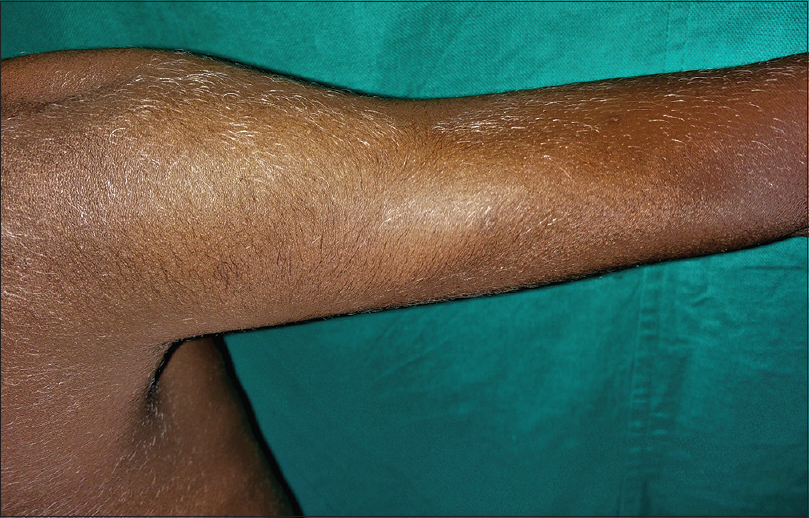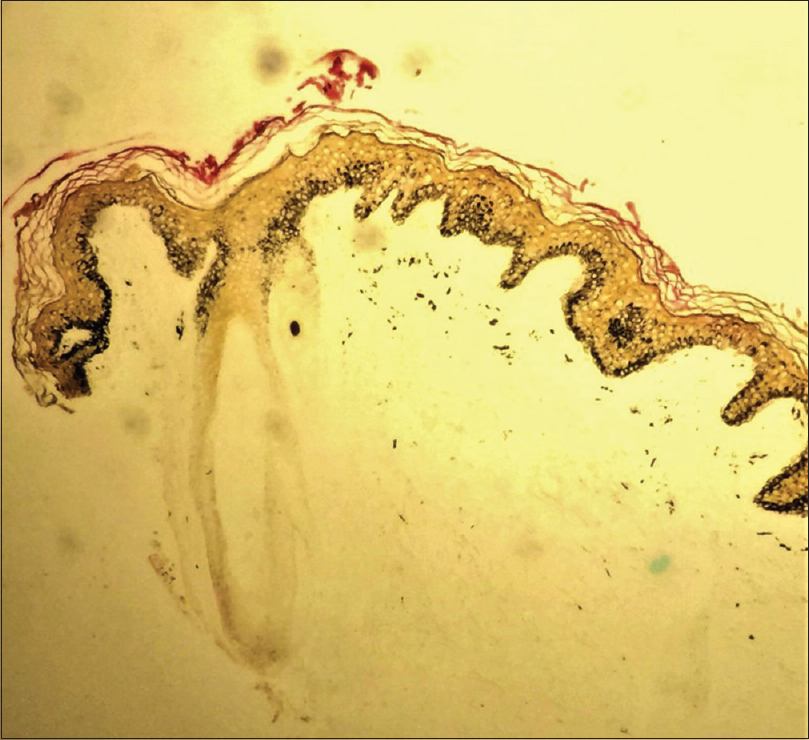Translate this page into:
Follicular vitiligo: A rare presentation of vitiligo
2 Department of Dermatology, Venereology and Leprology, AIIMS, Amaravati, Andhra Pradesh, India
3 Department of Dermatology, Venereology and Leprosy, JIPMER, Puducherry, India
Correspondence Address:
Munisamy Malathi
Department of Dermatology, Venereology and Leprosy, JIPMER, Puducherry
India
| How to cite this article: Kamat D, Prabhakaran N, Malathi M. Follicular vitiligo: A rare presentation of vitiligo. Indian J Dermatol Venereol Leprol 2019;85:414-415 |
Sir,
Leukotrichia is known to occur in vitiligo and usually follows the appearance of depigmented macules and is limited to the extent of the macules. It is a marker of disease progression and usually portends a poor prognosis for repigmentation. Follicular vitiligo is a recently proposed subtype which primarily involves the melanocyte reservoir in the hair follicle prior to affecting the epidermis. A 9-year-old South Indian boy presented with greying of hair all over the body followed by multiple depigmented macules over the face and trunk for 1 year. There was no personal or family history of premature greying. Typical depigmented macules of vitiligo with trichrome sign were present over the face and upper back [Figure - 1]. The depigmented macule over the forehead extended into the scalp with associated leukotrichia. Leukotrichia was seen over the macules and over normal-appearing skin [Figure - 2]. Dermoscopy also confirmed the absence of perifollicular depigmentation around the affected greyish-white hair follicles. Thyroid function tests were normal. Biopsy from a depigmented hair follicle over the normal appearing skin revealed absence of follicular melanocytes which was further confirmed by Masson Fontana staining [Figure - 3]. The surrounding skin had normal melanocyte density. There was no evidence of perifollicular inflammatory infiltrate. Hence, the diagnosis of leukotrichia was confirmed. He was started on whole-body narrow-band ultraviolet B phototherapy, but as he was irregular with treatment, he was able to receive only around six sittings over 4 months and then ultimately lost follow-up with us. There was no appreciable repigmentation noticed in either the depigmented macules or the depigmented hairs. Follicular vitiligo is a rare subtype of vitiligo, reported only in eight patients till now to the best of our knowledge.[1],[2] All the previous reported cases presented with significant generalized leukotrichia prior to the appearance of vitiliginous macules similar to this case. Coincidentally all eight cases were males and a family history of premature greying was present in three of them. Peripubertal age of onset was noted in three patients. One patient also had alopecia areata.[1] Preliminary observations suggested that follicular vitiligo could be a bridge between alopecia areata and vitiligo because the canities subita in alopecia areata resembles the diffuse greying in follicular vitiligo. Some consider it to be a forme fruste of alopecia areata. Our patient did not have any patches of alopecia. It has been suggested through molecular studies that epidermal and follicular melanocyte reservoirs function as two independent units and are antigenically distinct. Follicular vitiligo emerging as a new entity reinforces this finding. Perhaps follicular vitiligo and alopecia areata share a common follicular melanocyte autoantigen against which immune response is directed which could explain the preferential loss of pigmented hairs in the latter.[2] Long-term outcome of these patients remains uncertain. This subtype of patients would theoretically have poorer prognosis for repigmentation as the hair melanocyte reservoir itself is lost prior to interfollicular involvement.
 |
| Figure 1: Generalized leukotrichia with typical depigmented macules of vitiligo over trunk which appeared later |
 |
| Figure 2: Generalized leukotrichia over the arm in the absence of associated depigmented macules |
 |
| Figure 3: Absent melanocytes in the hair follicle with retained melanocyte density of the surrounding skin (Masson Fontana stain, ×10) |
Declaration of patient consent
The authors certify that they have obtained all appropriate patient consent forms. In the form, the patient has given his consent for his images and other clinical information to be reported in the journal. The patient understands that name and initials will not be published and due efforts will be made to conceal identity, but anonymity cannot be guaranteed.
Financial support and sponsorship
Nil.
Conflicts of interest
There are no conflicts of interest.
| 1. |
Ezzedine K, Amazan E, Séneschal J, Cario-André M, Léauté-Labrèze C, Vergier B, et al. Follicular vitiligo: A new form of vitiligo. Pigment Cell Melanoma Res 2012;25:527-9.
[Google Scholar]
|
| 2. |
Gan EY, Cario-André M, Pain C, Goussot JF, Taïeb A, Seneschal J, et al. Follicular vitiligo: A report of 8 cases. J Am Acad Dermatol 2016;74:1178-84.
[Google Scholar]
|
Fulltext Views
6,464
PDF downloads
1,873





